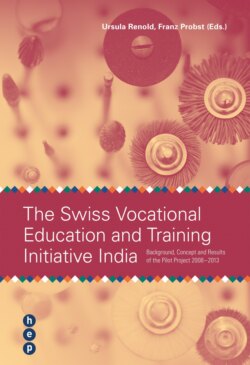Читать книгу The Swiss Vocational Education and Trainig Initiative India - Ursula Renold - Страница 8
ОглавлениеLiterature
Biavaschi, C., Eichhorst, W., Giulietti, C., Kendzia, M., Muravyev, A., Pieters, J., Rodríguez-Planas, N., Schmidl, R., & Zimmermann, K. F. (2012). Youth Unemployment and Vocational Training. IZA Discussion Paper No. 6890.
Finegold, D. (1999). Creating Self-Sustaining, High-Skill Ecosystems. Oxford Review of Economic Policy, 15(1) (pp. 60–81.)
Government of India (2009). National Skill Development Policy. www.skilldevelopment.gov.in/assets/images/NationalSkillDevelopmentPolicy-Mar09.pdf [accessed on 7.9.2015].
Hall, P. A., & Soskice, D. W. (Eds.) (2001). Varieties of Capitalism: The Institutional Foundations of Comparative Advantage. Oxford: Oxford University Press.
Hoffman, N. (2011). Schooling in the Workplace: How Six of the World’s Best Vocational Education Systems Prepare Young People for Jobs and Life. Cambridge, Mass.: Harvard Education Press.
ILO (2014). Skills Mismatch in Europe. Statistic Brief. Geneva: International Labour Organization.
Lang-Wojtasik, G. (2013). Das Bildungswesen in Indien. In: C. Adick (Ed.), Bildungsentwicklungen und Schulsysteme in Afrika, Asien, Lateinamerika und der Karibik (pp. 213–231). Munster: Waxmann.
Manufacturing Institute (2011). Boiling Point? The Skills Gap in U. S. Manufacturing. www.themanufacturinginstitute.org/Research/Skills-Gap-in-Manufacturing/2011-Skills-Gap-Report/Selected-Charts/Selected-Charts.aspx [accessed on 15.8.2015].
McKinsey (2012). The World at Work: Jobs, Pay, and Skills for 3.5 Billion People. O.O.: McKinsey Global Institute.
Mehrotra, S. (Ed.) (2014). India’s Skills Challenge: Reforming Vocational Education and Training to Harness the Demographic Dividend. New Delhi: Oxford University Press.
Mehrotra, S., Gandhi, A., & Sahoo, B. K. (2013). Estimating India’s Skills Gap on Realistic Basis for 2022. Economic and Political Weekly, 48(13).
Mehrotra, S., Raman, R., Kumra N., Kalaiyarasan, & Röss, D. (2014). Vocational Education and Training Reform in India, Business Needs in India and Lessons to be Learned from Germany. Gütersloh: Bertelsmann Stiftung.
OECD (2010a). Reviews of Vocational Education and Training. Paris: OECD.
OECD (2010b). Off to a Good Start? Jobs for Youth. Paris: OECD.
OECD (2015). Skills Outlook 2015. Paris: OECD.
Renold, U. (2002). Der dritte Lernort im Spiegel des Berufsbildungsgesetzes – unter institutionellen, ökonomischen Aspekten und Gesichtspunkten der Kooperation Wirtschaft – Staat. In: W. Goetze, P. Gonon, A. Gresele, S. Kübler, H. Landolt, N. Landwehr, R. Marty, U. Renold & P. Egger (2002), Der dritte Lernort: Bildung für die Praxis, Praxis für die Bildung (pp. 73–86). Berne: hep.
Renold, U., Bolli, T., Egg, M. E., & Pusterla, F. (2014). On the Multiple Dimensions of Youth Labour Markets: A Guide to the KOF Youth Labour Market Index. KOF Studies, No. 51. Zurich: KOF.
Schwab K., Sala-i-Martín, X., & World Economic Forum (2013). The Global Competitiveness Report 2013–2014. Basingstoke: Palgrave McMillan.
SKBF (2010). Bildungsbericht Schweiz 2010. Aarau: Schweizerische Koordinationsstelle für Bildungsforschung.
Strahm, R. H. (2008). Warum wir so reich sind. Wirtschaftsbuch Schweiz. Berne: hep.
Thelen, K. A. (2004). How Institutions Evolve. The Political Economy of Skills in Germany, Britain, the United States, and Japan. Cambridge: Cambridge University Press.
